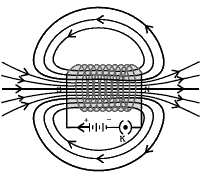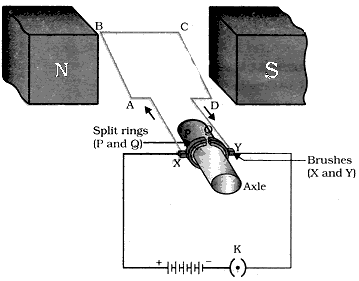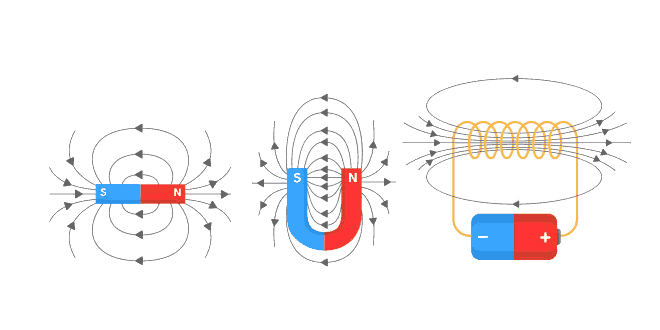Question: Name two safety measures commonly used in electric circuits and appliances.
Answer: The use of an electric fuse prevents the electric circuits and appliance from a possible damage by passing the flow of unduly high electric current. The Joule heating that takes place in the fuse melts it to break the electric circuit.
Question: An electric oven of 2 KW power rating is operated in a domestic electric circuit (220 V) that has a current rating of 5 A. What result do you expect? Explain.
Answer:
V = 220 V, I = 5 A
Power, P = VI
P = 220 × 5
P = 1100 W
Therefore, power P = 1100 W = 1.1 KW
Therefore, an electric oven of 2 KW power rating cannot be operated in a domestic electric circuit (220 V) that has a current rating of 5 A because electric oven has higher power than the power of the electric circuit.
Question: What precaution should be taken to avoid the overloading of domestic electric circuits?
Answer: Fuse is the most important safety device, to avoid the overloading of domestic electric circuits.
Too many appliances should not be connected to a single socket.
Question: List three sources of magnetic fields.
Answer:
a) Magnetic field due to a current through a straight conductor.
b) Magnetic field due to a current in a solenoid.
c) Magnetic field due to a current through a circular loop.
Question: How does a solenoid behave like a magnet? Can you determine the north and the south poles of a current-carrying solenoid with the help of a bar magnet? Explain.
Answer:

A coil of many circular turns of insulated copper wire wrapped closely in the shape of the cylinder is called a solenoid. The pattern of the magnetic field lines around a current- carrying solenoid is shown in this figure. In fact, one end of the solenoid behaves as a magnetic north pole, while the other behaves as the south pole. The field lines inside the solenoid are in the form of parallel straight lines. This indicates that the magnetic field is the same at all points inside the solenoid. That is, the field is uniform inside the solenoid.
A strong magnetic field produced inside a solenoid can be used to magnetise a piece of magnetic material, like soft iron, when placed inside the coil. The magnet so formed is called an electromagnet.
Question: When is the force experienced by a current-carrying conductor placed in a magnetic field the largest?
Answer: The force experienced by a current-carrying conductor placed in a magnetic field is largest provided when the direction of current is at right angles to the direction of the magnetic field.
Question: Imagine that you are sitting in a chamber with your back to one wall. An electron beam, moving horizontally from back wall towards the front wall, is deflected by a strong magnetic field to your right side. What is the direction of magnetic field?
Answer: The direction of magnetic field is towards west.
Question: Draw a labelled diagram of an electric motor. Explain its principle and working.What is the function of a split ring in an electric motor?
Answer:

A motor is a device that converts the electrical energy into mechanical energy.
Principle
An electric motor is based on the fact that when a current carrying conductor is placed in a magnetic field the conductor experiences a force which is given by Fleming’s Left Hand Rule. For example, when a rectangular coil is placed in the magnetic field and current is passed through it, a torque acts on the coil, which rotates it continuously. When the coil rotates, the shaft attached to it also rotates and therefore the electrical energy supplied to the motor is converted into the mechanical energy of rotation.
An electrical motor consists of a rectangular coil ABCD of insulated copper wire, wound on a soft iron core called armature. The coil is mounted between the poles of a magnet in such a way that it can rotate between the poles N and S. The two ends of the coil are soldered to the ends of a commutator whose main function is to reverse the direction of the current flowing through the coil every time the coil just passes the vertical position during its revolution.
Working
Suppose the coil ABCD is initially at a horizontal position. When the switch is in ON position the current enters the coil through the carbon brushes and the half ring ‘A’ of the commutator.
The current flows in the direction DCBA and leaves via the half ring ‘B’. In the side PQ of the coil, the direction is from Q to P towards the south and the direction of the magnetic field is from the N to S pole towards the east. So, by applying Fleming’s left hand rule, we find that it will experience a force in upward direction. Similarly, the side SR of the coil will experience a downward force. Thus we have two parallel wires experiencing forces in opposite directions. They form a couple tending to rotate the coil in the anticlockwise direction.
When the coil goes beyond the vertical position, the two commutator half rings automatically changes contact from one brush to the other. This reverses the direction of current through the coil which, in turn, reverses the direction of forces acting on the two sides of the coil. The sides of the coil are interchanged, but rotate in the same anticlockwise direction. This process is repeated again and again and the coil continues to rotate as long as the current is passing.
Question: Name some devices in which electric motors are used.
Answer: Electric fans, refrigerators, mixers, washing machines, computers, MP3 players etc are some devices in which electric motors are used.
Question: A coil of insulated copper wire is connected to a galvanometer. What will happen if a bar magnet is
(i) pushed into the coil, (ii) withdrawn from inside the coil, (iii) held stationary inside the coil?
Answer: (i) A deflection is observed in the galvanometer due to the induced current because of the changing magnetic flux (increasing) through the turns of the coil connected to the galvanometer.
(ii) A deflection is again observed in the galvanometer, as when it is pulled out, the flux linked with the coil due to the bar magnet decreases. Hence a current flows in the coil to reduce the change in flux. The deflection can be observed in the opposite direction as compared with the previous case.
(iii) No deflection is observed in the galvanometer. The flux linked with the coil due to the magnetic field is at a constant. Hence no current is induced due to the bar magnet.
Question: Two circular coils A and B are placed closed to each other. If the current in the coil A is changed, will some current be induced in the coil B? Give reason.
Answer: Yes, if the current in the coil A is changed, then some current will be induced in the coil B because due to the change in the magnetic field effect around the coils.
Question: State the rule to determine the direction of a
(i) magnetic field produced around a straight conductor-carrying current,
(ii) force experienced by a current-carrying straight conductor placed in a magnetic field which is perpendicular to it, and
(iii) current induced in a coil due to its rotation in a magnetic field.
Answer:
(i) Right-hand thumb rule
Imagine that we are holding a current carrying straight conductor in the right hand such that the thumb points towards the direction of current. Then our fingers will wrap around the conductor in the direction of the field lines of the magnetic field. This is known as Right-hand thumb rule.
(ii) Fleming’s left-hand rule
Fleming’s left-hand rule states that, stretch the thumb, fore finger and middle finger of the left hand such that they are mutually perpendicular. If the first finger points in the direction of magnetic field and the second finger in the direction of current, then the thumb will point in the direction of motion or the force acting on the conductor.
(iii) Fleming’s right-hand rule
If the thumb and the first two fingers of right hand are held at right angles to each other, with the Forefinger held in the direction of the field, and the thumb in the direction of motion, the induced current I flows in the direction of the middle finger.
 Class Notes NCERT Solutions for CBSE Students
Class Notes NCERT Solutions for CBSE Students





